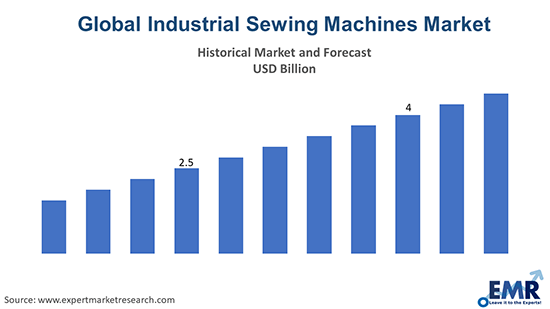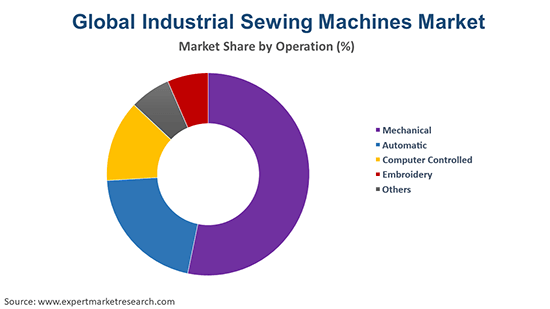
Consumer Insights
Uncover trends and behaviors shaping consumer choices today
Procurement Insights
Optimize your sourcing strategy with key market data
Industry Stats
Stay ahead with the latest trends and market analysis.
Trending Now



The global industrial sewing machines market size reached approximately USD 3406.80 Million in 2024. The market is assessed to grow at a CAGR of 5.90% between 2025 and 2034 to attain a value of around USD 6043.75 Million by 2034.
Base Year
Historical Year
Forecast Year
China is the world’s largest manufacturer of sewing machines. In addition, it is the world's largest exporter of textiles and garments.
The Brazilian Textile and Apparel Industry Association (ABIT) is made up of a total of 25,000 companies, including 23,000 apparel companies.
In March 2023, the Government of India announced the locations for setting up 7 PM Mega Integrated Textile Regions and Apparel (PM MITRA) parks for the textile industry.






Value in USD Million
2025-2034
Industrial Sewing Machines Market Outlook
*this image is indicative*
Industries using industrial sewing machines are shifting demand from woven fabrics to knitted fabrics in response to the rising preference for casual wear. The rise of fashion e-commerce and continuously changing fashion trends are stimulating the demand for more attractive clothing options. Compared to domestic sewing machines, these counterparts are designed to function continuously over extended durations without the risk of motor overheating.

Read more about this report - REQUEST FREE SAMPLE COPY IN PDF
Some of the factors driving the industrial sewing machines market growth are the demand to mass-produce apparel and non-apparel products, the need to reduce labour-intensive tasks, and the rising fashion consciousness among consumers.
Rising demand for apparel, advancement in industrial sewing machine technology, and expansion of online sales channels are driving the industrial sewing machines market development.
| Date | Company | Details |
| August 2023 | JUKI Corporation | JUKI Corporation and PEGASUS CO., LTD. formally established a capital and business alliance focused on the industrial sewing machinery sector. |
| February 2023 | Brother Industries, Ltd. | Brother Industries, Ltd. announced the strategic decision to construct a machine tool production facility near Bengaluru in southern India. |
| July 2022 | JUKI Corporation | JUKI Corporation, Mitsubishi Electric Corporation, and Meiryo Technica Corporation successfully established a Joint Venture Company in the industrial sewing machine business. |
| Trends | Impact |
| Demand for apparel and non-apparel products | The rising demand for clothes from men, women, and kids aids the market. The rise in disposable income and the influence of social media are influencing the demand for belts, handbags, shoes, etc. |
| Expansion of the e-commerce sector | With a rising number of individuals embracing online shopping, there's an increasing requirement for machines that can facilitate the manufacturing of garments and other products. |
| Advancing industrial sewing machines with automation | Clothing and accessory producers are adopting advanced automated systems within their supply chains to introduce greater organisation and labour efficiency. |
Many nations such as the United States, Saudi Arabia, and the United Kingdom are keen on improving their domestic manufacturing of garments to meet the demand of their respective countries and other nations through exports. This is expected to translate into a lucrative opportunity for the growth of companies engaged in the industrial sewing machine business.
By adopting advanced industrial sewing machines, end users are enhancing their productivity and efficiency. Automated industrial sewing machines enhance the performance of garment manufacturers and reduce their downtime.
Figure: Technological Innovation in Industrial Sewing Machines
Technological innovations in industrial sewing machines primarily focus on the following aspects:
| Intelligent Manufacturing | Digitalisation | Green Manufacturing |
| The integration of the Internet of Things (IoT) technology, artificial intelligence, and big data into sewing machines is enabling them to automatically identify fabrics, adjust parameters, and perform fault diagnostics. | The integration of sewing machines with digital technologies facilitates the collection, analysis, and application of production data. Consequently, it enhances production efficiency and management levels. | The rising need to reduce the emissions of the industrial sector has increased the adoption of energy-saving sewing machines. |

Read more about this report - REQUEST FREE SAMPLE COPY IN PDF
Global Industrial Sewing Machines Market Report and Forecast 2025-2034 offers a detailed analysis of the market based on the following segments:
Market Breakup by Product Type:
Market Breakup by Operation:
Market Breakup by Application:
Market Breakup by Region :
Mechanical sewing machines are widely adopted due to their cost-effectiveness; there by increasing the industrial sewing machines market share
Mechanical sewing machines are cost-effective and provide ease of maintenance as they work well with regular oiling. Mechanical sewing machines are affordable and can be easily maintained or repaired. The foot pedal allows the machinist to conveniently adjust their sewing speed. The manual functions also provide them complete control over stitches, thread tension, and stitch length and increase the efficiency of the sewing process.
Computer-controlled sewing machines provide functions, such as automatic cutting, dialing, and counting. Further, advanced computer-controlled sewing machines have a high degree of automation and can lower the burden on workers. According to the industrial sewing machines market report, high-performance industrial embroidery machines aid in the production of high-quality, versatile, unique embroidery designs using less time and effort.
By application, the apparel segment is expected to hold a significant market share owing to the rising fashion consciousness among consumers
The apparel segment is a crucial contributor to the industrial sewing machine market growth. The rising fashion consciousness and purchasing power of consumers support the application of industrial sewing machines to produce apparel.
Industrial machines, including heavy-duty cylinder beds and post-bed sewing machines, are designed for non-apparel manufacturing, like technical textile and leather manufacturing. The demand for luxury handbags, casual bags, high-end sneakers, and casual shoes aids the industrial sewing machines market development. The growing trend of assembling a complete outfit is not only increasing the demand for apparel but also non-apparel items such as shoes, belts, purses, and more.
The global industrial sewing machines market is assessed to be fragmented in nature with several players vying for the market.
| Company Name | Year Founded | Headquarters | Products/Services |
| JUKI Corporation | 1938 | Tokyo, Japan | Industrial and home sewing machines. |
| Brother Group | 1908 | Aichi, Japan | Garment printers, industrial sewing machines, and embroidery machines. |
| Mitsubishi Electric Corporation | 1921 | Tokyo, Japan | Industrial sewing machines with the brand name PLK-J and other electric and electronic equipment. |
| AMF Reece CR, sro | 1991 | Prostějov Czech Republic | Industrial sewing machines, including hole punch, chain stitch laundry, autojig template sewing, and pocket machines. |
Other key players in the industrial sewing machines market include BERNINA International AG and JACK Sewing Machine Co., Ltd., among others.
Asia Pacific is expected to hold a significant industrial sewing machines market share driven by a robust garment manufacturing sector
Countries in Asia Pacific, such as China and Japan are prominent industrial sewing machine producers. China is the largest producer of sewing machines in the world. It has a complete industrial chain with an annual output exceeding 70% of the world, according to industry reports. Currently, six major sewing machinery industry clusters are formed in Zhejiang, Shanghai, Jiangsu, Guangdong, Shaanxi, and Tianjin. In addition, it is the world's largest exporter of textiles and garments, serving as a clear testament to the robust competitiveness of its textile and apparel sector.
The fashion and apparel sector in Europe is a key driver of the industrial sewing machines market. For instance, in 2020, there were around 8,245 manufacturers in the United Kingdom's fashion and textile sector. Of this, garment manufacturers were around 4,005. Leicester is the primary hub of the United Kingdom’s garment sector, comprising approximately 1,000 to 1,500 factory units.
According to the industrial sewing machines market report, increasing inclination towards domestic clothing manufacturing, coupled with the strategy of meeting global demand through higher clothing exports, favours the need for top-notch industrial sewing machines in North America.
Latin America Explosives Market
Oceania Rotating Equipment Market
Australia and New Zealand Cleaning Services Market
Indonesia Waterproofing Market
Germany Refurbished Retail Market
Industrial Sewing Machines Market Size
Industrial Sewing Machines Market Trends
*While we strive to always give you current and accurate information, the numbers depicted on the website are indicative and may differ from the actual numbers in the main report. At Expert Market Research, we aim to bring you the latest insights and trends in the market. Using our analyses and forecasts, stakeholders can understand the market dynamics, navigate challenges, and capitalize on opportunities to make data-driven strategic decisions.*
Get in touch with us for a customized solution tailored to your unique requirements and save upto 35%!
In 2024, the market attained a value of nearly USD 3406.80 Million.
The industrial sewing machines market is assessed to grow at a CAGR of 5.90% between 2025 and 2034.
The market is estimated to witness healthy growth in the forecast period of 2025-2034 to reach about USD 6043.75 Million by 2034.
Industrial sewing machines are designed to mass-produce goods and run at higher speeds. These machines aid the stable production of high-quality garments.
An industrial sewing machine is designed for heavy-duty use to sew through thick materials, such as leather, canvas, and multiple layers of fabric.
The major market drivers include the constantly evolving fashion trends and the increase in online clothing sales through e-retail platforms.
The key trends pushing the market growth are the growing preference for high-end sewing machines among industrial manufacturers and the expanding apparel and non-apparel manufacturing sector globally.
The major regions in the market are North America, Latin America, the Middle East and Africa, Europe, and the Asia Pacific.
The major product types of industrial sewing machines include flatbed, cylinder bed, post bed, and feed-off-arm, among others.
The major players in the market are Juki Corporation, Brother Group, Mitsubishi Electric Corporation, AMF Reece CR, sro, BERNINA International AG, and Jack Sewing Machine Co. Ltd., among others.
Explore our key highlights of the report and gain a concise overview of key findings, trends, and actionable insights that will empower your strategic decisions.
| REPORT FEATURES | DETAILS |
| Base Year | 2024 |
| Historical Period | 2018-2024 |
| Forecast Period | 2025-2034 |
| Scope of the Report |
Historical and Forecast Trends, Industry Drivers and Constraints, Historical and Forecast Market Analysis by Segment:
|
| Breakup by Product Type |
|
| Breakup by Operation |
|
| Breakup by Application |
|
| Breakup by Region |
|
| Market Dynamics |
|
| Competitive Landscape |
|
| Companies Covered |
|
| Report Price and Purchase Option | Explore our purchase options that are best suited to your resources and industry needs. |
| Delivery Format | Delivered as an attached PDF and Excel through email, with an option of receiving an editable PPT, according to the purchase option. |
Datasheet
One User
USD 2,499
USD 2,249
tax inclusive*
Single User License
One User
USD 3,999
USD 3,599
tax inclusive*
Five User License
Five User
USD 4,999
USD 4,249
tax inclusive*
Corporate License
Unlimited Users
USD 5,999
USD 5,099
tax inclusive*
*Please note that the prices mentioned below are starting prices for each bundle type. Kindly contact our team for further details.*
Flash Bundle
Small Business Bundle
Growth Bundle
Enterprise Bundle
*Please note that the prices mentioned below are starting prices for each bundle type. Kindly contact our team for further details.*
Flash Bundle
Number of Reports: 3
20%
tax inclusive*
Small Business Bundle
Number of Reports: 5
25%
tax inclusive*
Growth Bundle
Number of Reports: 8
30%
tax inclusive*
Enterprise Bundle
Number of Reports: 10
35%
tax inclusive*
How To Order
Our step-by-step guide will help you select, purchase, and access your reports swiftly, ensuring you get the information that drives your decisions, right when you need it.

Select License Type
Choose the right license for your needs and access rights.

Click on ‘Buy Now’
Add the report to your cart with one click and proceed to register.

Select Mode of Payment
Choose a payment option for a secure checkout. You will be redirected accordingly.
Track prices with detailed trend reports.

Analyse trade data for supply chain insights.

Leverage cost reports for smart savings

Enhance supply chain with partnerships.

Gain insights to stay ahead and seize opportunities.

Get insights & trends for a competitive edge.

Track prices with detailed trend reports.

Analyse trade data for supply chain insights.

Leverage cost reports for smart savings

Enhance supply chain with partnerships.

Gain insights to stay ahead and seize opportunities.

Get insights & trends for a competitive edge.

Track prices with detailed trend reports.

Analyse trade data for supply chain insights.

Connect For More Information
Our expert team of analysts will offer full support and resolve any queries regarding the report, before and after the purchase.
Our expert team of analysts will offer full support and resolve any queries regarding the report, before and after the purchase.
We employ meticulous research methods, blending advanced analytics and expert insights to deliver accurate, actionable industry intelligence, staying ahead of competitors.
Our skilled analysts offer unparalleled competitive advantage with detailed insights on current and emerging markets, ensuring your strategic edge.
We offer an in-depth yet simplified presentation of industry insights and analysis to meet your specific requirements effectively.



Australia
63 Fiona Drive, Tamworth, NSW
+61-448-061-727
India
C130 Sector 2 Noida, Uttar Pradesh 201301
+91-723-689-1189
Philippines
40th Floor, PBCom Tower, 6795 Ayala Avenue Cor V.A Rufino St. Makati City,1226.
+63-287-899-028, +63-967-048-3306
United Kingdom
6 Gardner Place, Becketts Close, Feltham TW14 0BX, Greater London
+44-753-713-2163
United States
30 North Gould Street, Sheridan, WY 82801
+1-415-325-5166
Vietnam
193/26/4 St.no.6, Ward Binh Hung Hoa, Binh Tan District, Ho Chi Minh City
+84-865-399-124
United States (Head Office)
30 North Gould Street, Sheridan, WY 82801
+1-415-325-5166
Australia
63 Fiona Drive, Tamworth, NSW
+61-448-061-727
India
C130 Sector 2 Noida, Uttar Pradesh 201301
+91-723-689-1189
Philippines
40th Floor, PBCom Tower, 6795 Ayala Avenue Cor V.A Rufino St. Makati City, 1226.
+63-287-899-028, +63-967-048-3306
United Kingdom
6 Gardner Place, Becketts Close, Feltham TW14 0BX, Greater London
+44-753-713-2163
Vietnam
193/26/4 St.no.6, Ward Binh Hung Hoa, Binh Tan District, Ho Chi Minh City
+84-865-399-124
Share